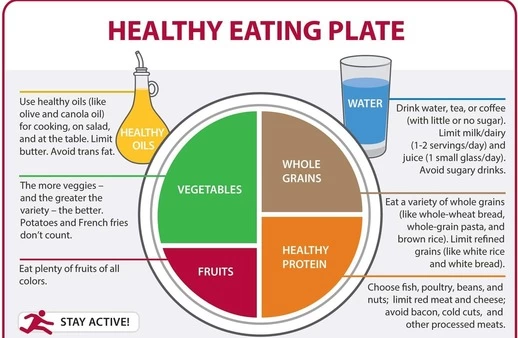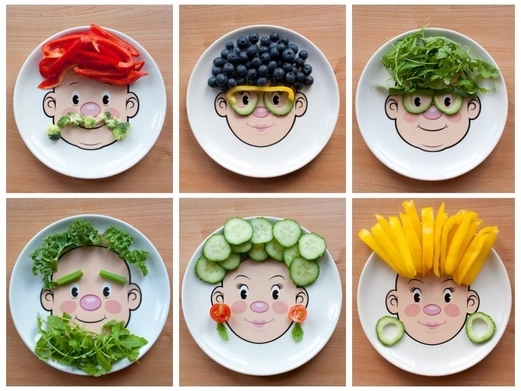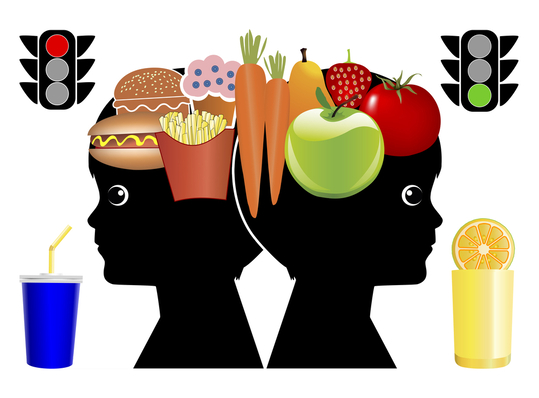
DON’T WANT A PICKY EATHER –
FOLLOW THE THIRTY RULES OF GOOD EATING HABITS
1. DON’T TELL YOURSELF THAT CHILDREN ARE NATURALLY FUSSY
As a rule children aren’t fussy as babies: they gobble down the puréed carrot, eat the mushed up cauliflower cheese and generally seem to enjoy whatever comes their way.
Children start to become fussy when they are two or three years old. Why does it happen at this age? Because it is at this point that children catch onto the fact that we really, really care about what they eat and that fussy eating is going to get them a lot of attention.
Children are not naturally fussy – but they will become so if the conditions are right! Follow these listed rules consistently and you should start to see a little progress after two weeks, and a lot after three or four months.’
2. FORGET EVERYTHING YOUR MOTHER OR GRANDMOTHER TOLD YOU
(You’re going to sit there till everything is eaten)
(You won’t grow big and strong if you don’t eat your vegetables)
(Finish that last bit. It’s not good to waste food)
(Think of all the starving children)
‘As a parent you will get a lot of different advice, but be selective about what you choose to follow. Times have changed. Tackling fussy eating may mean a few teaspoons worth of wasted food, but the emphasis should be on the enjoyment of food.’
3. DON’T LABEL YOUR CHILD A FUSSY EATER
From about the age of three to nine, children’s brainwaves look like the brainwaves of an adult under hypnosis. So when you say something to a child in that age range, it is instantly absorbed and accepted as ‘the truth’ without question. The purpose of this is that it allows children to learn huge quantities of information easily. The downside is that they can whole-heartedly absorb attitudes and values – including beliefs about themselves – which may be detrimental!
4. GIVE UP YOUR POWER
Don’t invite children to a power battle in the first place. When it comes to eating, behave as if you have no power. Completely let go of the parent-to-child authority that you use in other areas of life. Just simply give your child their food and act as if you don’t mind whether they eat it or not.

5. STAY IN CONTROL OF THE SHOPPING AND COOKING
Make sure you’re in control of snacks too – both what and when! Left to their own devices, many children would happily graze through the day. There can be a temptation to withhold snacks, thinking it will make your child more likely to eat their lunch or dinner, but letting them get voraciously hungry and irritable isn’t going to be a good lead up to mealtimes. Give children a snack mid-morning and mid-afternoon to keep their mood even. It would be reasonable to offer a choice if it’s no trouble, but limit it to two things (eg. banana or toast). It is reasonable to let your child choose a meal occasionally as a treat, but not more than once a week.’
6. DON’T USE PUDDING AS A REWARD OR PUNISHMENT
Dangling pudding in front of your child as a means to eating their meal. The message it gives is this: the main course is not that enjoyable. Eating it is a chore. But it’s something you just have to endure to get to the pudding – which is the delicious bit and the bit worth getting to.
7. DON’T PUSH THEM TO EAT EVERYTHING ON THEIR PLATE
Let your child decide the amount they eat. The motto should be ‘Eat as much or as little as you like’. Once the pressure of being expected to eat it all – or a certain amount – is taken away, the mood will be lighter and more laid-back. We’ll be giving our children the message that food is enjoyable – not a chore or an endurance test. And very importantly, we won’t be inviting them to yet another battle of wills! It may take a little while, but they really will start to eat more of what we want them to eat, not less.
8. DON’T TELL THEM TO EAT THE FOOD – LET ALONE MAKE THEM
We actually have more – not less – chance of them eating what we want them to eat if we don’t tell them to. Telling children to eat something is just another way of showing them how much we care. We’re offering attention for not eating something and inviting them to battle it out with us. It puts them firmly in the driving seat. Finally, never, ever make your child eat something. Don’t force them to sit at the table until they’ve eaten it, for example, or spoon feed them food they don’t want. Never use dominance or restraint in any way. That’ll make the table a very unhappy place and could create some very deep, long-term issues around food.
9. KEEP THEIR DIET AS SAVOURY AS POSSIBLE
You can be sure the more sugar you give a child, the more they’ll want. It really does grease the slippery slope to fussy eating and makes it much harder to reverse it. Aim to re-adjust their diet so that 80-90% of it is savoury. Stick to a once-a-week ‘Sweets day’. Don’t always have pudding or end meals on a sweet note.

10. KEEP OFFERING THEM THE FOODS THEY DON’T EAT
Research shows that it can take children 15–20 times of being offered a food before they will be receptive to the idea of eating it. If we don’t put it on their plate in the first place, we will be taking away the opportunity to ever reach that point. If we don’t at least expose them to it, it will be impossible to increase the number of different foods they eat. And to avoid lots of food wasteage, just put a very small amount on their plate in the first instance.
‘Exposure to food is a really important first step in building children’s trust and confidence in their ability to experience new foods. We need to get them used to having it on their plate regardless of whether they eat it or not.
11. DON’T BUY INTO THE IDEA OF “CHILDREN’S” FOOD
Buying these types of foods simply encourages fussy eating. It puts the idea into our and our children’s heads that they shouldn’t – or can’t – eat the same food as adults. That they should stay within certain boundaries. That they have ‘special’ food needs and desires that parents should cater to. Boiled carrots probably aren’t going to interest you that much if you’ve got used to being given carrot from a squeezy pouch!
12. DON’T GIVE A RUNNING COMMENTARY AT MEALTIMES
This kind of commentary is annoying, it gives your child incredible power again. If I don’t eat this, or that, thinks the child, it will really bother them and I’ll get more attention. Give your child their food and then say nothing about it. Talk about other stuff instead. Don’t watch and monitor their every mouthful like a hawk either – or at least don’t let them see you doing this! This way, your child really is more likely, not less likely, to eat what you hope they’ll eat!
13. KEEP INTRODUCING THEM TO NEW AND UNFAMILIAR FOODS
At first, make gradual and tiny changes to the food shopping. For example, if you usually buy pasta spirals, buy pasta tubes instead. If you usually get yellow cheddar, get a slightly orangey-coloured one for a change. If you usually cook plain pork sausages, substitute pork and apple sausages. Remember, at no time put any pressure on them to actually eat the new food. As time goes on, you can take bigger, braver steps. (Have a completely different vegetable with dinner tonight)
14. DON’T TELL THEM WHAT THEY LIKE AND DISLIKE
Telling or reminding our children of their likes and dislikes can only exacerbate fussy eating because it completely undermines an open, flexible and adventurous attitude towards food. It reinforces in our child’s head two lists of foods: the ones they like and the ones they don’t – as if these are permanent, fixed, unchangeable things.

15. DON’T HIDE THE VEGETABLES
‘Never lie to your child about food. It builds up mistrust. If one day your child notices that you’re putting cauliflower into the mashed potato, for example, they won’t eat it anymore and they won’t trust you anymore. It could make them suspicious, about other foods too.’It is important to present vegetables boldly and proudly. We only hide and disguise stuff that is bad or unpleasant in some way – like a spot on our face or a stain on the rug. It is important to present vegetables boldly and proudly. We only hide and disguise stuff that is bad or unpleasant in some way – like a spot on our face or a stain on the rug.It doesn’t matter if they don’t eat the vegetables, just keep putting them on their plate. Persist and be Patient. Children are much more likely to try a vegetable or fruit if they’ve grown it themselves. Watching things grow is exciting and exposes them to vegetables and fruit in their natural state.
16. KEEP PREFERENCES AS PREFERENCES
The danger is, that when we notice that your child prefers ham sandwiches to cheese sandwiches, or strawberries to raspberries, we stop serving the other. As a result, preferences quickly solidify into ‘will eats’ and ‘won’t eats’. Not only is there a tendency to cook the ‘reliable’ meals that we know our children will eat without a fuss, we may just be too busy to put much time and thought into what we’re going to cook. But before we know it, we can count the number of meals our children will eat happily on one hand. Get out of the rut. Expand the menu and spiral back upwards!
17. BAN WORDS LIKE YUCK, I DON’T LIKE THIS, OR I DONT WANT THAT
Tell your children that they can think them or say them silently in their heads if they want to. But from now on, they must say nothing negative about any food they encounter whatever they think about it. The best time to tell them about the rule is at another time entirely, when you are nowhere near food and feeling calm. Turn it into a sort of game or challenge: let’s see if you can avoid saying these words – EVER! Encourage your children to describe their experience with food, the texture, taste, smell.
18. GO EASY ON THE PRAISE
The reward for eating is EATING! Tasting lovely, delicious food and having that nice, satisfied feeling of a full stomach. Research shows that overpraising our children can reduce their interest in doing whatever it is we are praising them for: They think to themselves: Hmmm…if mum thinks this is such a big deal, maybe I’m not supposed to like doing it. Not only that, constant praise is another way of showing them how much we want them to eat – handing the power over to them yet again.
19. NEVER STOP THEM TRYING SOMETHING DIFFERENT OR UNUSUAL
It encourages fussiness because it teaches them all of the following things in one fell swoop:
1.Be very cautious about trying new foods – it’s better to stick to foods you are familiar with.
2.There are foods you definitely won’t like.
3.There is a clear-cut line between ‘adults’ food’ and ‘children’s food’.
4.Children should only eat bland foods.
These are all the very opposite of what we want them to think!

20. RELAX ABOUT TABLE MANNERS
Babies and toddlers naturally want to learn about the world through their senses. Just as they put toys in their mouth, they want to touch food. So when they’re this age, let them stick their fingers in it, feel it, squidge it, squelch it, sniff it, see what noises it makes… Food is, after all, sensual in more ways than taste. Don’t let your desire for them to have good table manners interfere with their enjoyment and exploration of food. In the big scheme of things, getting nutritious food inside our children through non-fussy eating is way more important than what happens on the ‘outside’. The best time to teach table manners isn’t at mealtimes at all. We don’t want reprimands or negativity around food. Choose a completely different time – when no-one’s hungry – and turn it into a game!
21. HAVE A SWEETS DAY ONCE A WEEK – AND STICK TO IT
Children do not need sweets to survive or be happy! Choose one day of the week to buy your children sweets from the shop. Then stick to it with superglue! Never wobble! Never waver! Never give in to pestering! Beware: If you do ever crumble and give in, you’ll make the situation much worse, because it will teach them they just have to pester harder to get what they want! When you’re shopping in the supermarket with your child, a great ‘treat’ to substitute for sweets is a single fresh bread roll from the bakery section. It’s good because it’s easy, It can actually become something they look forward to on a shopping trip!
22. LET THEM EAT AT THEIR OWN PACE
It’s all too easy to interpret slow eating as fussy, reluctant eating or to think their slowness is a sign that they don’t really like the food or to assume that they’re not going to eat much of it. But a slow eater is not necessarily a fussy eater – or a small eater. Some children just eat slowly! ‘Don’t rush mealtimes. Aim for at least 30 minutes dedicated time with no interruptions or distractions.
23. OFFER THE VEGETABLES FIRST
If your child is anti vegetables, give them some vegetables before their main meal. Present them while you are still cooking as a sort of ‘mini-starter’. This isn’t a replacement for giving vegetables with the main meal – you should still serve those too. But vegetables are going to look a lot more enticing when they’re hungry and they’re much more likely to eat them. The kind of thing you could give is:
•a handful of still frozen, ultra-crunchy sweetcorn or peas straight from the freezer in a tiny dipping bowl or egg cup
•crunchy, shredded, white cabbage with soy sauce to dip it in
•a ‘kebab’ of cherry tomatoes and cucumber on a stick
•carrot sticks, celery sticks, sticks of red pepper with hummus or another dip
•pickled vegetables like olives or roasted peppers with cocktail sticks (supervise with younger children)
•a small bowl of salad with a dressing. Don’t make a big thing of it. Just present the vegetables nonchalantly while they’re still playing, watching TV or chatting to you. Say nothing at all or just something casual along the lines of, Here’s something to snack on while you’re waiting for your dinner if you fancy it. Doesn’t matter if you don’t.
24. DON’T USE FOOD AS EMOTIONAL COMFORT
We are presenting food – especially sweet, fatty, salty foods – as having the power to make the world okay again. This sub-consciously trains children to turn to food when they’re feeling upset or down, regardless of their body’s needs – and is likely to give them a stronger leaning towards unhealthy foods. So next time your child is crying, fight the urge to ‘plug’ the noise with food. Use cuddles and sympathy instead. Although it may take a little longer to quieten them down, it is a much better solution. And for older children with a bigger or more complex issue that is upsetting them, a proper chat with some good listening is a better solution than How about a piece of cake? or Let’s go to McDonalds for lunch to cheer you up
